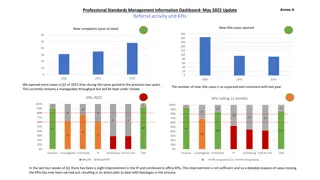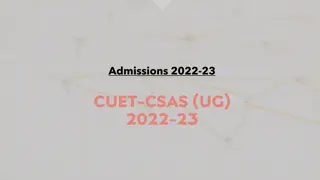Natural Killer Cells and Their Functions
Natural killer (NK) cells are a type of large granular lymphocytes that play a crucial role in innate immunity. Unlike T cells, NK cells do not require immunization to target and kill certain tumor cells and virally infected cells. They express specific surface markers like CD16 and CD56, distinguishing them from T cells. NK cells can be stimulated by IL-2 to enhance their cytotoxic capacity, leading to the creation of lymphokine-activated killer (LAK) cells. Understanding the functions and characteristics of NK cells can provide insights into their role in immune responses and potential therapeutic applications.
Download Presentation

Please find below an Image/Link to download the presentation.
The content on the website is provided AS IS for your information and personal use only. It may not be sold, licensed, or shared on other websites without obtaining consent from the author.If you encounter any issues during the download, it is possible that the publisher has removed the file from their server.
You are allowed to download the files provided on this website for personal or commercial use, subject to the condition that they are used lawfully. All files are the property of their respective owners.
The content on the website is provided AS IS for your information and personal use only. It may not be sold, licensed, or shared on other websites without obtaining consent from the author.
E N D
Presentation Transcript
NATURAL KILLER CELLS Natural killer (NK) cells are large granular lymphocytes that, like CTLs, use cytoplasmic granules containing perforins to kill target cells. NK cells were defined initially by their ability to lyse certain tumor cell lines and virally infected cells in vitro. In contrast to T cells, NK cells can lyse these cells without prior immunization, and so mediate a form of innate (or natural) immunity that is termed natural killing.
Unlike T cells, NK cells do not productively rearrange their TCR genes, and they do not express a cell surface TCR/CD3 complex. They also lack CD4, the marker for T helper cells. About half of human NK cells express CD8, the marker for cytolytic T cells, but only one form of CD8 is expressed (a homodimer of two chains), and it does not appear to be required for natural killing. (It is not found on mouse NK cells.) Most NK cells express CD16 (a receptor for the Fc portion of IgG) and CD56 (a variant of neural cell adhesion molecule, NCAM). Neither of these is required for natural killing, and they are expressed at different levels in different tissues. They nonetheless serve to identify NK cells, which are generally CD16+, CD56+, CD3-, whereas T cells are CD3+, CD16-, CD56-.
NK EFFECTOR FUNCTIONS The cell surface molecules that NK cells use to selectively recognize targets for natural killing have not been well defined. All NK cells express a surface receptor called NKp46, and blockade of this receptor impairs natural killing. Almost all NK cells also express and are activated by 2B4, a receptor that binds to CD48, which is expressed on most hematopoietic cells. These receptors may be important in natural killing, but their role is not yet fully defined.
lymphokine-activated killer (LAK) cells When NK cells are stimulated by IL-2, their cytotoxic capacity is enhanced, and the range of target cells they can kill is greatly broadened. These lymphokine-activated killer (LAK) cells have been used clinically to treat tumors. Treatment, however, requires the administration of IL-2 in toxic doses, and success has been limited, so this therapy has not gained wide use. Activation by IL- 2 induces NK cells to express NKp44, an activating cell surface receptor that is not expressed by resting NK cells and that may help to enhance killing.
NK Cells function The CD16 Fc receptor on NK cells permits them to bind and lyse cells that are coated with antibody. This antibody-dependent cell-mediated cytotoxicity (ADCC) provides a bridge between the innate and acquired immune systems. Natural killing, by contrast, occurs independently of antibodies. NK cells also kill hematopoietic blasts, and so present a barrier against bone marrow transplantation. As discussed later on, inhibitory receptors on NK cells that recognize class I MHC antigens influence graft rejection. The preferential activation of NK cells by hematopoietic cells may account for the reduction in formed blood elements, including white cells, red cells, and platelets, that has been found in patients with abnormal proliferation of NK-like cells. Activated NK cells produce cytokines such as IFN , colony-stimulating factor, and colony-stimulating factor-1. The production of IFN by NK cells may serve to bias a T-cell response toward TH1 differentiation. NK cells are not, however, required for all TH1 responses because these can also be generated through the production of IFN by T cells. , TNF granulocyte-monocyte
INHIBITORY RECEPTORS ON NK CELLS RECOGNIZE CLASS I MHC ANTIGENS Unlike T cells, NK cells do not require the expression of MHC molecules on target cells for activation. Instead, NK cells are generally inhibited by the expression of class I MHC proteins on target cells. This inhibition is mediated by receptors on NK cells that specifically recognize class I antigens and deliver inhibitory signals. NK cells express inhibitory receptors that identify both self and nonself class I MHC antigens. All NK cells, however, express at least one inhibitory receptor for a self class I MHC antigen. By this means, NK cells are prevented from killing cells from their host. The inhibitory receptors on NK cells are of two structural types: immunoglobulin-like (Ig-like) and lectin-like. The Ig-like receptors are members of the immunoglobulin gene superfamily (see Chapter 7) and are called killer inhibitory receptors (KIRs). The KIRs are encoded by a gene family on chromosome 19, and different members of the family interact with different sets of class I MHC proteins. Different KIRs recognize features that are common to large groups of class I MHC molecules, so that two KIRs, for example, identify mutually exclusive subsets
Missing self The finding that NK cell function is inhibited by class I MHC has given rise to the missing self hypothesis. This model proposes that unlike cytotoxic T lymphocytes, which must be activated from a resting state by contact with an appropriately presented foreign antigen, NK cells are always predisposed to kill any cell they encounter, but are prevented from killing host cells because they recognize the host class I proteins. Thus, they only attack cells whose class I MHC proteins are lost or altered (missing self), as occurs frequently in malignancy or viral infection.























